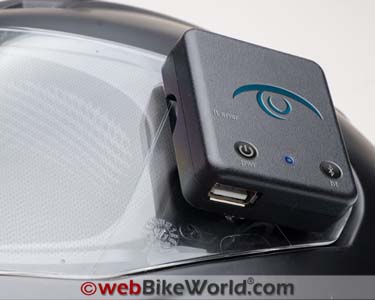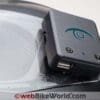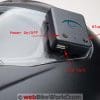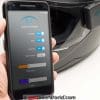A new night vision motorcycle helmet visor technology may end up being a real game-changer for those who ride in the dark.
This Scotopia Technologies unit we’re reviewing is a pre-production sample.
However, it proves the concept of adding night vision capabilities to a motorcycle helmet.
It’s the first visor to apply night vision technology to a motorcycle helmet.
Being able to see in almost complete darkness not only increases rider safety in a huge way, but you have to admit, it’s also pretty cool.
Maybe the technology BMW Motorrad VISION NEXT 100 technology from just last year isn’t as far off as we thought!
Although the BMW system takes the concept one step further, because the rider in that video had no helmet at all, just some rather high-tech eyeglasses.
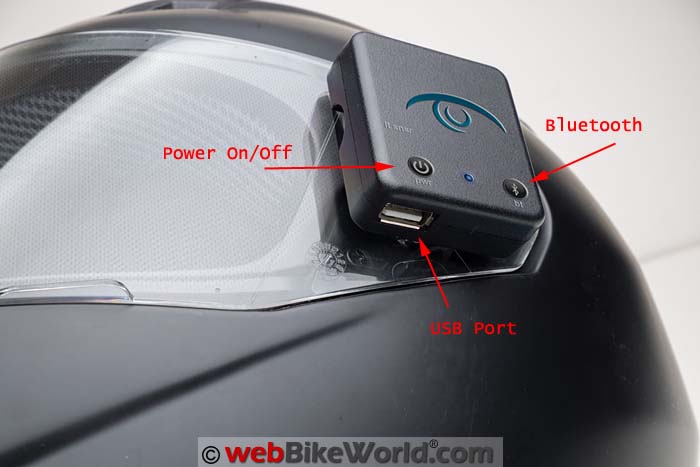
Background
Technology can be a wonderful thing, but it can also be a distraction…especially when riding a motorcycle.
With mobile phones, Bluetooth, intercoms and action cameras all vying to come along for the ride these days, it is easy to have one’s attention diverted from what’s important, the road ahead.
So when our Editor asked me if I wanted to a review yet another “whiz-bang” technology gadget for motorcycle riders I sighed a little inside as I responded “Sure” to his email.
I love techie toys and gadgets as much as the next guy but geez, I‘m running out of room for this stuff on the Kawasaki Ninja 1000 (review).
So included in my “Sure” response was, of course, a question asking what the device will be this time.
His response was a bit ambiguous. He informed me it was a helmet with a “pretty slick feature” and that’s all he said.
I asked if he could tell me more, but he simply responded with “just check out Scotopia Technologies“. Obviously, he wanted me to check this out for myself.
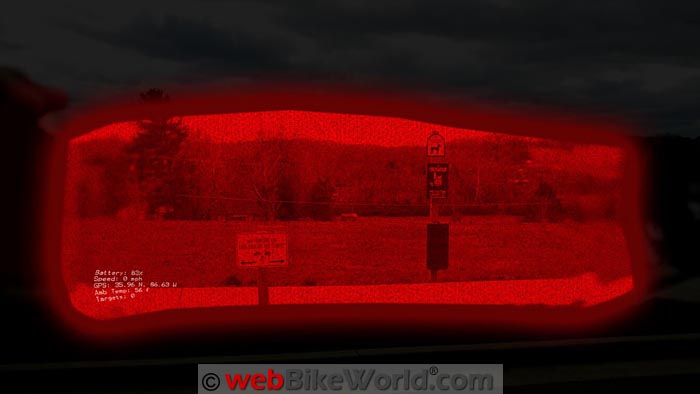
Scotopia Technologies
I wasn’t aware of Scotopia Technologies, but a quick web search turned up the company website and after reading about what they do, I admit I was intrigued.
The Scotopia Technologies website describes the company as being “…on the bleeding edge of low light imaging capture and display research”.
The word “Scotopia” is derived from “scotopic” defined in Wikipedia as basically “vision in dim light” and “the ability of the eye to adjust for night vision”. So the name started to make sense.
With all the evidence in front of me, I had to assume that I was getting to review a helmet with some kind of vision enhancement system, but as cool as that sounds I was still skeptical.
The recent debacle with the Editor’s $1,500.00 order for the Skully HUD helmet that ended up being vaporware has left many of us cold towards any “bleeding edge technology” for helmets.
The Scotopia NVx Helmet Visor
The box that arrived at my door contained an unbranded generic-looking motorcycle helmet with nothing more than a DOT sticker and size label.
On the left side of the visor is a small “black box” (literally) that uses a stick-on to bond to the polycarbonate surface of the helmet.
The NVx visor is a tool-less removal design that will be made to fit a variety of helmet brands. The visor has a sort of haze that at first makes it seem like a peel-off protector strip but when I looked through from the inside, I could see a faint pattern.
Looking around in the box for the owner’s manual, all I found was a simple sheet of paper with the words “Do Not Overflex the Faceshield!” printed largely at the top.
Below the large headline it read “Hyperflexion can cause damage to the sensor array and display elements in the face shield: Use Caution”.
The only other information on the page was just a simple instruction about downloading the Scotopia app from the Google Play Store and holding down the Bluetooth button for 4 seconds to initiate pairing once it is installed.
Also “be sure to fully charge the device before use” was printed at the bottom.
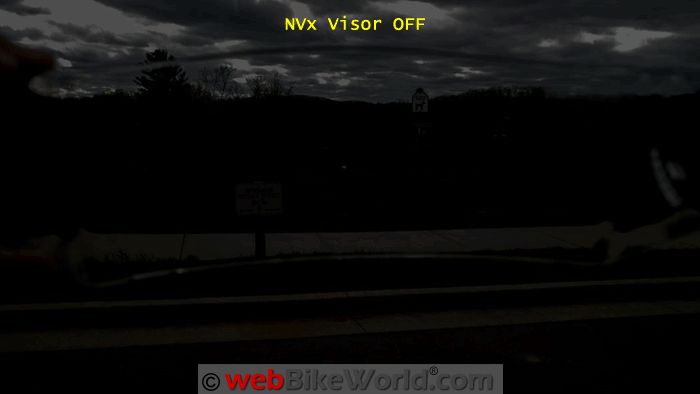
The NVx Control Module
That box on the side of the visor serves as both the battery pack and control interface for the NVx Visor. All of the electronics, the CPU and firmware are contained in the visor and the permanent control box.
As I understand it, Scotopia has tentative agreements to make face shields for some of the major players in the industry. Of course they wouldn’t tell me who is lined up at this point, only that we’ll find out “soon”.
The control box is a model of simplicity, with a power button, a Bluetooth button and a single LED. A standard USB port is used for charging.
The helmet included a USB charging cord that had the same connector at both ends for charging via a computer or other type of USB charger.
I guess they assumed I had a charger, and they were correct, but I understand a charger will be included with the final product.
The only other feature of note is a cutout that faces forward with the letters “lt snsr” screen printed near it.
I plugged in the USB charging cable and while it was charging I looked at the interesting, but meager, information on the Scotopia website.
“CompoundEye” and “FlexIris” Technologies
Two technologies that are used in the NVx night vision visor are called “CompoundEye” and “FlexIris”.
According to Scotopia, CompoundEye is a type of imaging device that doesn’t use traditional lenses, at least not the kind we think about on a camera or phone.
Instead, each sensor “cell” has it’s own micro-lens, allowing a matrix of sensors to be laid out onto a substrate using a process similar to 3D printing.
Microlenses are not really new technology as they have been used in digital cameras sensors for years.
The particular type in use here are called micro-Fresnel lenses and these use concentric curved surfaces to amplify and direct light to each sensor.
You’ve probably seen fresnel lenses before on a larger scale like those magnifier sheets one can get at the office supply store.
CompoundEye has been “printed” into the visor here and covers about 75% of the face shield area used in this pore-production sample.
FlexIris is essentially the opposite of CompoundEye in that it displays images instead of capturing them.
The face shield contains an array of OLED’s (Organic Light Emitting Diodes) that are covered with microlenses. The micro-lenses used in FlexIris are quite a bit different from the micro-lenses used in cameras or the CompoundEye technology.
The “Flex” in FlexIirs refers to a clear polymer material that changes shape when an electric current is applied.
Much like LCD’s, the electric charge can affect the material nearly instantly and draws very little power in use.
The flexible material is used to create a layer of lenses over the OLED’s in the visor so that the image displayed on the inside of the visor appears to be several feet away rather than just a few inches.
This FlexIris layer is adjustable so that the focus can be set where it is most comfortable for the viewer.
It is important to note that this display cannot compensate for corrective lenses so if you wear eyeglasses or contacts like me, you still need when using the NVx visor.
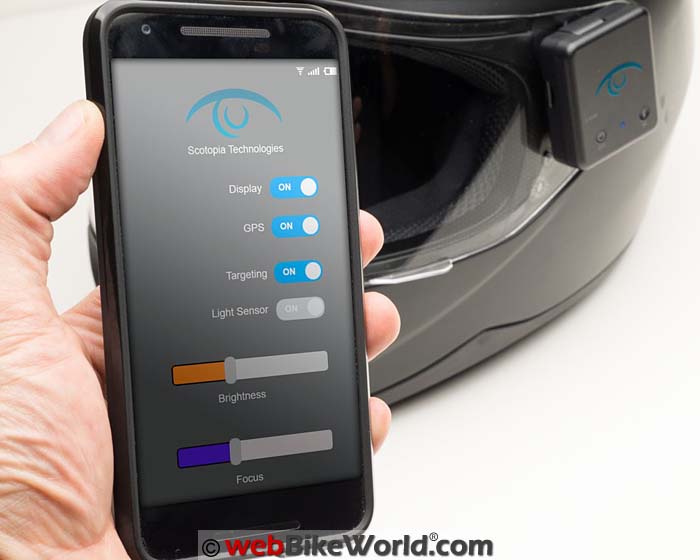
Using the NVx Visor App
After a couple of hours, the red LED on the control box of the NVx visor went green. I assumed that this meant it was charged, as the documentation that was sent was rather sparse.
In the meantime, I downloaded and installed the app on my Nexus 5X. The app is pretty small and it installed in less than a minute.
Once the app is started, the system will prompt you to turn on and pair the NVx visor with the phone. It’s the standard pairing procedure: press and hold the Bluetooth button until the LED flashes red and blue and pair with the visor.
I pressed the button in the app to turn on the NVx system for the first time and I instantly noticed the visor now looked clear from the outside.
Apparently, once power is applied, all of the micro-components go to a baseline position making the “cloudiness” go away that is present when it is off.
Powering On the NVx Visor
With the pairing complete, the app now shows a diagram of a helmet.
Here is the list of options in the app:
- On/Off/Auto turns the visor on or off. The auto option is not working yet on this sample (firmware 0.7b) but it will be enabled on updated samples as they closer to production.
- Light Sensor: Apparently that “lt snsr” call out on the side is where the light sensor will be located for auto mode sensing, although this sample just has an empty space there.
- Brightness Slider: This, as you might guess, raises or lowers the brightness of the display while the GPS switch will connect to the GPS in your mobile device and display it on the visor if desired.
- Focus: Focus allows you to adjust the FlexIris display for your eye-to-visor distance.
- Target Outline: This is just as it sounds. Any hazards or “targets” within view are outlined in a bright white line to make them easier to spot on the display. Of course you can turn this off using this option if you find it distracting.
First Impressions of the NVx Visor
All that was left to do now was to test the NVx in the real world of night-time.
With the visor flipped up, I headed to a spot where there were no street lights and the road dead-ends into a dark woods.
I thought this would be a good way to test the nigh vision system, as there isn’t any traffic in this area and the trees will give me something to “see” (and maybe a deer or other critter would pop out of the woods).
Next, I shut the bike off and got set to turn on the NVx. Pulling out my phone, I opened the app and switched the NVx to “On”.
In front of me the world turned red! A blurry crimson mess was all I could see. Adjusting the brightness down, the red glow dimmed to a reasonable level at around 30%. Certainly bright enough, I’d say.
Slowly an image formed in front of me as my eyes adjusted.
The NVx renders the world in shades of red, the idea being that red lighting doesn’t adversely affect your normal night vision so it is less jarring when you open the visor.
Even with the overall red tint, the view is pretty good actually; it’s no “Iron Man” suit but closer to the view from something like the Terminator in the James Cameron movies.
I could see the trees and the road clearly enough but the display does have a hint of “scan lines” like on an older TV, but instead of being distracting, it was actually pretty cool looking.
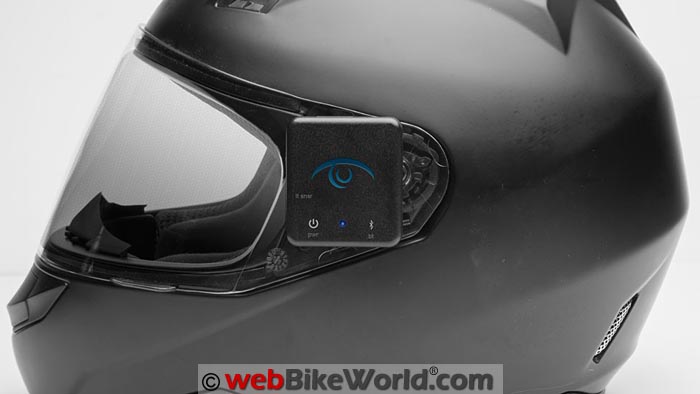
Riding With the NVx
With the NVx all set, I hopped back on the bike. I reached forward and pulled the headlight connector on the Ninja so all was dark in front of me and then I put the tight helmet back on.
I proceeded at a slow speed down the narrow two-lane road and despite the lack of headlight or streetlights, I could easily see the road, the white lines on the side, and the trees along the road.
Of course they were all tinted in the night vision red, but the point is I could see everything, even though the only ambient light was from the stars and a low-set moon that was only a quarter full.
Also, in addition to objects and the road itself, the NVx also displays battery capacity, GPS coordinates, ambient temperature, speed, and number of targets.
Conclusion
The Scotopia NVx night vision visor is an amazing piece of technology. The pre-production sample I was provided has its issues but that doesn’t take away from the potential of this technology.
I think if a full-color version were available this would be an easy sell, although I understand why the red screen is the preferred way to go here, at least at this stage.
Plus, I understand that not trying to capture color information leaves more luminance data (brightness) which is part of what enables the low light capabilities.
No pricing has been set yet but I’ve been told it will run anywhere from $2,399.00 to $2,899.00 MSRP. The word from Scotopia is that the target for pricing is under $1,500.00 after the first year or two of production.
Is that a steep price to pay for night vision? Perhaps, but this is an amazing bit of technology that can allow you to see those deer on the side of the road even before they know you’re there.
And not having to use the headlight on your motorcycle also reduces glare to oncoming vehicles, which can only help.
Bottom line? If you ride at night, you need one of these!
Owner Comments and Feedback
See details on submitting comments.
From “B.G.” (April 2017): “I have received a follow on question from a fellow Facebook member, watching this post / tech: “How will this device react to oncoming headlights?” Enquiring minds want to know…”
Editor’s Reply: The developer said “It’s no problem, you only get blinded until the oncoming car passes you.”
From “H.H.” (April 2017): “I can’t believe nobody asked the obvious question — does it work with the Ride ‘n’ Watch Motorcycle TV system?”
From “M.G.” (April 2017): “As cool as this seems, I would much rather see thermal imaging integrated into the visor.
This would not be sensitive to light, and would have the benefit of letting you see that which your eyes might not see, like the suicidal deer that’s laying in the grass on the side of the road, just waiting to jump out in front of you.”
Editor’s Reply: You mean like this?:

From “C.B.” (April 2017): “Do you know if they have any plans to make them for bicycle helmets too? That way I could still get in my daily 25 mile bicycle ride when I get home from work and it’s dark outside.”
From “H.S.” (April 2017): ”
From “D.F.” (April 2017): “Uhh. No headlight. If people can’t see you coming then it doesn’t matter what you see.
Whether they get glare or can’t tell what you are or not at least they are aware that something is there. If you can’t use the head light then you can have it.”
From “L.N.” (April 2017): “Are they going to make a visor for use on a half helmet? This would be the nuts for pig hunting at night.
I just tried shooting with my full face helmet on and find I cannot get my cheek to the stock for a good consistent sight picture.
Technology is so great these days here is a link to another hi-tech product you might appreciate.”
From “B.G.” (April 2017): “I guess I’ll have to wait for the ‘semi-full color’ version. I can not focus red objects, in a dark room.
Not only do the longer wavelengths give good eyes focus related problems, my eyes have some macular degeneration (age related) that displays (to my brain) red points as ‘red triangles’.
So, if the target audience is the generations with money, then I suppose they’ll have to compensate for ‘old eyes’ syndromes, too.”
From “T.R.” (April 2017): “Did anyone else catch that he’s riding without a headlight?
At first I thought that was crazy but the more I think about it, the more it makes sense because no one can figure out what a single-headlight motorcycle is at night anyway, most drivers think it’s a bicycle.
So you’re probably better off riding without the headlight and with the night visor turned on anyway.”
From “S.B.” (April 2017): “The price seemed pretty high at first but if you hit one deer in an accident it would cost more than the visor easily and if you died in the crash you’d regret not having bought one of these.”
From “L.V.” (April 2017): “I kind of wish I could just put my cell phone in a handlebar holder and look at that instead, the night vision technology should go right through the app only and then I wouldn’t even have to bother with having to look through the visor.”


